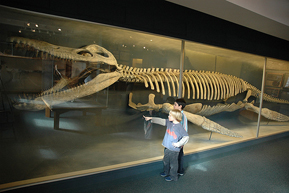Nearby Attractions: Harvard’s Museum of Natural History
Rare, extinct, and strange old animal specimens — with flowers

Checking out the animals at the Franklin Park Zoo (while they’re still safe from state budget cuts) can be fun, but if you’re in the mood to see rare or extinct animals and specimens, there’s always the Harvard Museum of Natural History.
The HMNH was created in 1998 as the umbrella name for three venerable institutions — the Museum of Comparative Zoology, the Mineralogical and Geological Museum, and the Harvard University Herbaria. They’re housed in a large red brick building on the Harvard campus in Cambridge. More than 165,000 visitors come through the doors every year, making this the most visited attraction at Harvard.
Right away, you’ll find a coelacanth — a fish thought to be extinct for millions of years before it was found in the 1930s off the coast of South Africa. The size of a small child, it is preserved in a large fish tank in the middle of the gallery.
Also on display are vertebrates, invertebrates, jellyfish, dinosaur fossils, fish, bugs, rodents, birds, plant life, rocks, and minerals; if it’s on the Earth, it’s probably represented here. But the HMNH isn’t showy. Animals are displayed in simple glass cases with white placards giving genus and species (eighth grade biology refresher, anyone?). The smell of mothballs wafts through every room. Wooden floors creak loudly, which can be startling if you’re staring into the eyes of a Bengal tiger and footsteps unexpectedly thud behind you. Sometimes small pieces of skin have come off an animal on display and fallen to the bottom of the case. Many specimens literally burst at the seams, showing plaster or straw filling underneath, reminiscent of a B-grade horror flick.
If some specimens show their age, it’s because many date to the 19th century, according to Mary Blue Magruder, the museum’s director of communications and marketing. “For many years, there was no climate control in the galleries, and this resulted in deterioration,” she says. “All galleries are now climate-controlled, and the museum has begun evaluating and renovating older exhibits, taking into consideration their historic value, the condition of the specimens, the possibility of repair or replacement, and the potential for incorporating current research into the displays.”
Unlike a zoo, this museum allows you to get close — really close. It’s amazing to stand within a foot of a red kangaroo, perched as if about to leap, and realize that it’s about three feet tall, something hard to decipher from a photograph. The Tasmanian devil doesn’t look very scary up close, but weighing about 15 pounds and resembling a raccoon, it can kill prey three time its size.
The museum regularly has new exhibits, talks with scientists, and family activities.
Less fascinating to most kids is the mineral collection, but adults might covet the rocks as jewelry. Chalcopyrite looks like gold, galena like it arrived from the planet Krypton. This part of the museum, unlike the animal areas, is well lit and airy, inviting visitors to spend more time searching for different types of rocks. Knowledgeable museum workers are available to answer questions.
Be sure to take in the amazing and beautiful glass flower collection. There are more than 3,000 models of glass flowers created by German artisans Leopold Blaschka and his son Rudolph. The collection, covering more than 830 plant species, is almost 125 years old. The models are so lifelike that the difference between them and real flowers is barely discernible. Designed to teach biology students about different parts of a plant, the exact replicas are part art, part history, and part science.
On a plaque near a model of the extinct dodo bird is a quote from famed writer and biologist Edward O. Wilson, Harvard University’s Pellegrino University Research Professor in Entomology: “The vast majority of species are not monitored at all . . . they pass from the earth without notice.” The mission here is to buck that trend, to celebrate what is — and what has been.
The Harvard Museum of Natural History is open daily from 9 a.m. to 5 p.m., except holidays. Admission is $7 with a Terrier Card; general admission is $9, seniors $7, and children $6. The museum is at 26 Oxford St., Cambridge, a stone’s throw from Harvard Yard; walk to Harvard Square (about 25 minutes from the BU Bridge along the river), cross the open space of the yard to Oxford Street. The Peabody Museum of Archaeology and Ethnography, which focuses on human cultural history, is in the same building. Admission to both museums is included in the ticket. More information is available here.
Amy Laskowski can be reached at amlaskow@bu.edu.

Comments & Discussion
Boston University moderates comments to facilitate an informed, substantive, civil conversation. Abusive, profane, self-promotional, misleading, incoherent or off-topic comments will be rejected. Moderators are staffed during regular business hours (EST) and can only accept comments written in English. Statistics or facts must include a citation or a link to the citation.